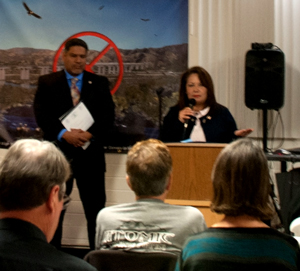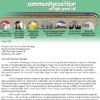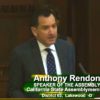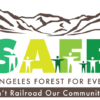Crazy things are going on in Sacramento with the High-Speed Rail Authority. They are always marching forward on their high-speed rail project despite the fact that there are no private investors willing to put their money where their mouth is. The possibility of federal funds is nearly nil and the Authority can’t get their hands on the Prop 1A bond funds due to non-compliance of the voter initiative.

California Assembly Member Patty Lopez at SAFE’s Dec. 2nd Community Update Meeting.
Even Democratic Assemblywoman Patty Lopez (D-San Fernando) says she is pulling the plug on her support for the Rail Project and has stated five other Democratic members are considering the same thing. Is it time when someone is willing to say, the Emperor has no clothes? See the LA Times article on the subject.
The billion-dollar question is realistically how can they promise construction in so many areas when there are so few dollars to spread across the segments? The only quantitative money being spent seems to be planning money that benefits primarily the consultants. There are very limited construction dollars available to spend.
To refresh your memory, here’s what they have:
Federal funds:
The feds have given the project grants in total of approximately $3.48 billion. $2.55 billion (ARRA money) must be spent by September 30, 2017. The other money, known as 2010 money is $929 million and must be spent by December 31, 2018. The strings with the ARRA money is the state must match each federal dollar spent. The Authority is behind in their obligations to match the federal funds spent. They also must build something with independent utility (providing standalone value if the rest of the project is not built) This section of new track runs parallel to the current BNSF track used by Amtrak in the Central Valley was deemed satisfying that federal requirement. But in fact, stopping parts of the current service in favor of this new proposed segment will take away some local stops that people use for their everyday life such as getting to work and going to medical facilities.
The Authority says using this new track will cut down travel time by 45 minutes but considering the negatives of this plan, one wonders why it was permitted. We’ve heard little talk if they are progressing on this federal requirement.
There is outright hostile reception to California’s project obtaining any additional funding and Congressman Jeff Denham vows to hold federal hearings in the first part of 2016 to discuss the viability of the project and question the spending of federal grant funds.
State funds:
The state bond measure had two parts. One was $950 million for connectivity funds and those have been mostly spent. Those transit modes receiving this grant money would theoretically make connecting to high-speed rail easier. There are question marks about the spending of those funds such as bond funds for the Central Subway that do not touch the high-speed rail system at Transbay Terminal.
The next part of the bond measure is the $9 billion dedicated for the planning and construction of the high-speed rail project.
The catch is that for the bonds to be sold and used for construction for a high-speed rail system, it must be proven that requirements are met such as completion of environmental work and the source of funding for the entire usable segment. At the moment, the Authority chose Merced to the San Fernando Valley and they have neither completed the environmental work nor have identified the funds for the construction of that segment. Therefore, the Authority cannot get their hands on any construction money using bond funds.
The spending of federal and state funds may continue for non-construction related activities such as planning until the Rail Authority reaches its maximum of 7½% of the $9 billion in bond funds.
According to a letter written back in September 18, 2013 by Deputy Attorney General Michele Inan, the state expenditures at that time had reached 49.11% of the $675 million for environmental studies, planning and preliminary engineering work. “
The law also provides that 2.5% of the $9 billion is allowable for administrative costs and that means they can spend up to $900 million in federal funds before they hit the wall. Are they there yet?, is the question.
Bookend spending:
Also under the category of state funds there was an appropriation passed in July 2012 allowing spending of $1.1 billion for Southern and Northern California. This is known as “bookend spending” specifically $500 million for the South and $600 million for the North. The Authority says these are for projects that will be needed for the installation of high-speed rail eventually and give some near term improvements as well to those areas.
Many question this spending since Prop 1A says that this money must be used for the planning and construction of the high-speed rail system. No one knows when or if high-speed trains will come to the bookends so pre-spending these funds is seen as problematic. This appropriation was no doubt with the intent to quiet the Legislative representatives who would not vote for the overall appropriation unless they got something out of the deal.
At the May 5, 2011 meeting, Authority Board Member Lynn Schenk refused to vote for the “blended system” in Northern California saying, to be blunt, she believes she thinks this is a bail-out of Caltrain, a northern California commuter line, and she for one, doesn’t want to see these precious HSR funds that they fought hard to come by used to bail out any regional transportation system.
Then Chairman Curt Pringle agreed with Schenk, “why would they spend HSR dollars to electrify a corridor in which we may never be able to build on.” He notes that recently that Congresswoman Anna Eshoo sent a letter saying give us HSR money to electrify Caltrain. Pringle suggests it might be a smokescreen to get their share of dollars for local rail use.
But despite wanting to spend these funds, the Authority cannot get their hands on this bookend money due to non-compliance of Prop 1A legislation. In fact, no one can count the remaining Prop 1A funds as a sure thing even though right now it is probably in the range of a remaining $8 billion. Though $2.7 billion of those funds have been appropriated, spending them is an entirely different thing.
Cap-and-Trade Funds: (More state funds)
The High-Speed Rail Authority promised Legislative leaders they would build in the Southern direction so that they would be able to get the votes to capture 25% of the cap-and-trade auction revenues. The federal government estimates this number at $500 million per year. (If the project’s first segment will cost $40 billion, how long will it take to finish the first usable segment?) The use of this money for the rail project which will be GHG negative for decades, robs the state of really deserving projects that could have an immediate positive effect on the environment. There are two lawsuits that will be heard next year that could end the spending of this money on this project.
No Private investment
Oct. 6, 2015 CHSRA Board Meeting. (See around the 4:00 minute marker.)
In this clip from the October 6, 2015 board meeting, Dan Richard gives his opinion of where they are as far as private investment. He admits the project needs new money. He says they are too early to attract the investors because the Authority cannot give a guarantee of a certain amount of revenue since it’s prohibited by law, nor can the Authority demonstrate proven ridership. “We’re not there yet, “ says Richard. Board Member Rossi later confirmed there was no pledge of private funds in this project. See the entire 30 minute Youtube video on this subject.
The Authority clearly admits the project has extremely limited construction funding available to build even the first segment from Merced to the San Fernando Valley that they chose in July 2012. At a cost of as much as $40 billion to build that first segment and no immediate solution as to how they will get over the Tehachapi mountains, there is a real possibility they will turn and go the other way, Bakersfield to the Bay area. See this article written on the subject. Only time will tell. The first draft of the newest legally required business plan will come in late winter, early spring of 2016.
In the meantime they are rushing to finish environmental work from Merced to San Jose and San Jose to San Francisco. The real rush is that the Authority needs to have a large majority of the federal funds spent by September 2017 or they have to give the remaining funds back. Regardless of what direction they choose, heading south or north, they will start in the Central Valley since that is where the federal fund grants say the dollars must be spent.
Southern California communities have issues with the project:
Despite the acute lack of funding, the Rail Authority still is pushing at least one segment in the South, the Palmdale to Burbank segment. Why? A combination of politics and some delusion that they will join with the Desert Xpress high-speed rail project, an equally dismally funded project, thought to help them be successful. Perhaps they believe there is hope to gain synergy with both of them together pushing for their projects. See the LA Times article on the subject.
Looking back on June 9th when the Authority hosted their monthly board meeting to discuss the Southern routes from Palmdale to Burbank, there was an uprising by the communities. The Authority said it would take a careful look at all the routes under consideration and promised to remove “show stopper” routes that just couldn’t happen. They have not done that.
There are strong negative reactions to most of the routes presented. There are those who want the project to go under-ground and save communities as well as the affordable rural land, and those that want to see the project to go at ground to avoid tunneling under the Angeles National Forest which they say could effect water supplies and be near seismic fault lines.
Please read this extensive article about the June 9th meeting. Of one of the organized groups, Save Angeles National Forest for Everyone (SAFE), is livid about the lack of progress in their segment. They want all surface transportation route elements eliminated immediately and is demanding better and more honest communication.
Dave De Pinto heading up SAFE and President of the Shadow Hills Property Owners Association, contends that after a year, the Rail Authority hasn’t done what they promised and is not listening to their concerns. In DePinto’s, “I’m as mad as hell and not going to take it anymore” letter sent December 8th to the Authority, he makes it crystal clear that their communities will not just sit by and perish at the hands of the Authority. DePinto says they refuse to be held hostage by the Rail Authority.
The next article will be Dave DePinto’s “Anniversary letter” to the Authority and to Legislators in their districts.




